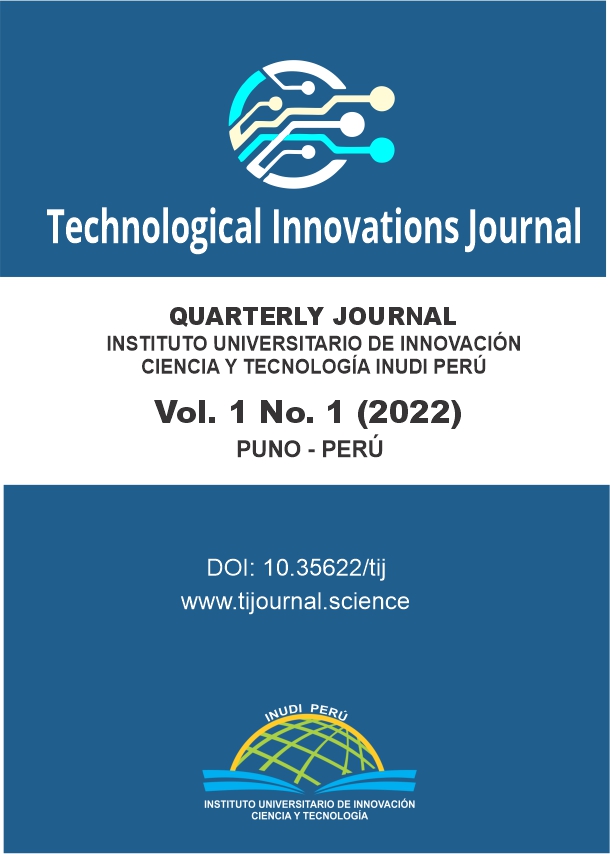Electrodeposition of Nickel in metallic materials in disuse
DOI:
https://doi.org/10.35622/j.ti.2022.01.004Abstract
This study carried out the electrodeposition of nickel in used iron metallic materials, which was called cathode to verify the adequate conditions, these processes were carried out in the laboratories of the Faculty of Metallurgical Engineering of the Altiplano National University, the investigation sought find the parameters of temperature, humidity, pH to conditions of Puno department. Such data is different from the electrodeposition in the regions of the coast and the Peruvian jungle, for which the objective of verifying if the electrodeposition process will be able to satisfy the expected expectations in the coating of metals through the watt’s methodology was raised. The number of tests was constituted by the electrodeposition of 20 half-inch tubes previously subjected to a washing process and prepared for their electrolytic bath, in a number of four units every 10 minutes. To verify quality control, weight differences were carried out. Obtaining the results of appropriating voltage of 2.0V, amperage of 1.5A and a time of 10 minutes are the ideal parameters obtained in the nickel electrodeposition process at environmental conditions of the high plateau region.
References
Abdel, Z., (1998). Mathematics and Chem and Physic, Butterworth Publishers, Edith. Stoneham.
Asli, E., Surndras, N., Tewari & Orhan, T. (2008). Electrodeposition of nickel nanowires and nanotubes using various templates, Journal of Experimental Nanoscience, 278-295.
Ballester A. & Wiley R. (2000). Electrodeposición del oro en láminas de cobre, Colombia, Editorial Limusa.
Biswas, A. (1993). Metalúrgica extractive del Cobre y deposición electrolítica, revista Ainsa. Prentice Hall.
Cambi L., & Piontelly, R. (2001). Modern electroplating, Fifth Electro-chem, 925.
Chao, G., Yu, Z., Xuhui, Z., Jingmao, Z., Jinping, X. (2008), The effects of electrodeposition current density on proprieties of Ni- CNTs composite coatings, Surface Coatingws Technology, 3246 – 3250. DOI: https://doi.org/10.1016/j.surfcoat.2007.11.032
Diabrai, G. (2010). Modern Electro deposition of Nickel, New York, Prentice Hall.
Holm, M. & Kofe, T. (2000). Evaluation of nickel deposition by electrochemical impedance spectroscopy, Electro-chem, 30-55.
Koparal, A. & Ogutveren, A. (2002). Ulker Bakir. Removal of nitrate from water by electroreduction and electrocoagulation. Journal of Hazardous Materials B89 83–94. DOI: https://doi.org/10.1016/S0304-3894(01)00301-6
Langer, S. & Roberth, M. (2001). Cupric chloridre Leaching of Model SulfurCompounds for Simple Cooper, Pensilvania, McGraw Hill.
Macheras, J., Vouros,D., C. Kollia, C. & Spyrellis, J. (1996). Nickel electrocrystallization influence of Unsaturated Organics Additives on the Mechanism of Oriented Crystal Growth, Trans. Inst, 55 – 74. DOI: https://doi.org/10.1080/00202967.1996.11871093
Raymond, C. (2002). La Electroquímica y sus procesos, España, McGraw Hill.
Rosenqvist, T. (1987). Fundamentos de Metalurgia Extractiva, Madrid, McGraw Hill.
Valencia, N. (2013). Anteproyecto de instalación de una planta de cromado.
Wesley, W. & Carey, J. (1999). The Electrodeposition o nickel chloride solutions, Experimental Nanoscience, 209-236. DOI: https://doi.org/10.1149/1.3498368
Published
Issue
Section
License
Copyright (c) 2022 Jhon Mamani, Gregorio Palomino (Autor/a)

This work is licensed under a Creative Commons Attribution 4.0 International License.











